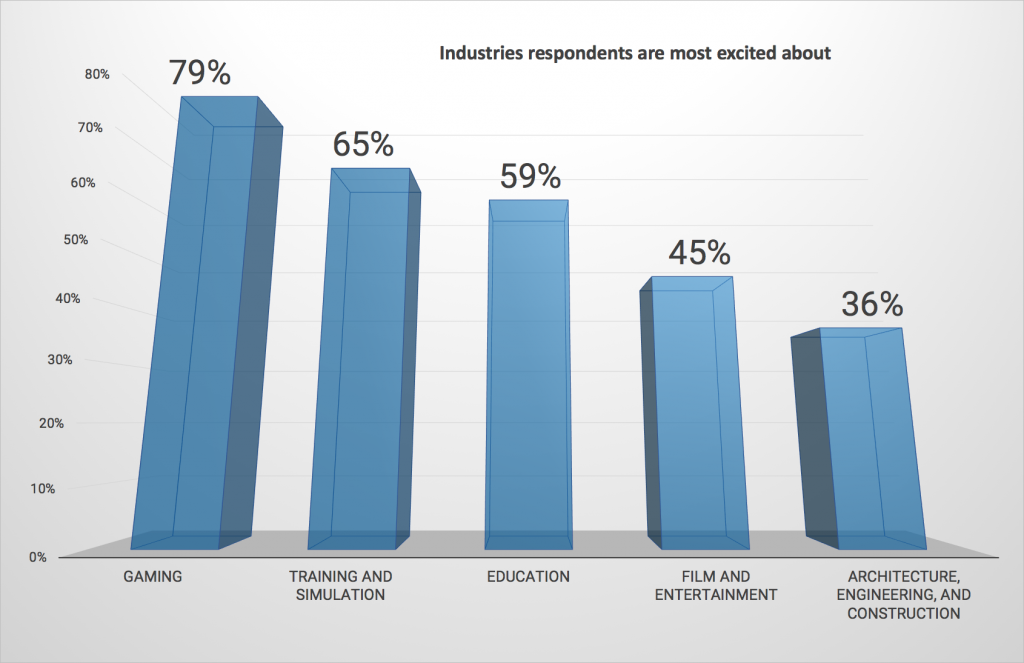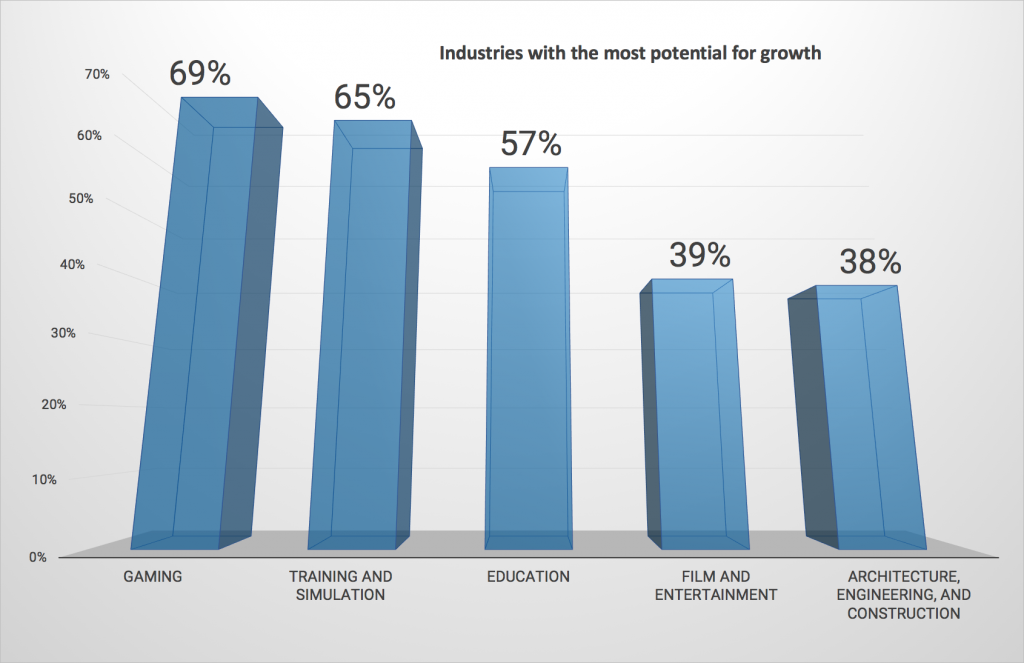8 Key Takeaways From Developers On The Virtual Reality Industry Today
8 Key Takeaways From Developers On The Virtual Reality Industry Today

In October 2018, HTC Vive asked developers to complete a survey about the current landscape of Virtual Reality. With over 1,800 respondents, the results are in, providing a look at how developers view the industry.
Understanding how developers are thinking about the VR industry, applications and the future of VR is important as the space continues to grow and application trends emerge. The survey insights help drive how Vive approaches the developer community providing the resources and tools that developers need the most.
Below are some key insights we found about the world of developers and VR.
- Audience
When it comes to who developers are targeting, 55% of respondents stated consumers as their main audience followed by 32% who listed enterprise.
HTC’s store for VR apps, Viveport, offers a variety of games, non-gaming apps, and videos for users to interact with. With Viveport, developers can reach both Vive and Oculus owners. Vive Wave allows developers to gain access to the all-in-one (AIO) audience – Wave is available on Vive products, but also on five additional hardware partners. Both of the platforms offer consumer and enterprise content while targeting both audiences.
- Creative Exploration
Creativity is at the core of developers. When respondents were asked why they develop content for VR, 78% stated for creative exploration.
Vive encourages developer creativity through an interactive forum for developers to collaborate. The Viveport Community Forum is a place where developers can share ideas, ask questions, get feedback, get inspiration for current/future projects and bounce ideas off people.
- Future Forward
There’s something about being a part of new and innovative technology. 40% of respondents stated they are developing VR-based apps because they are excited to be at the forefront of new technology. This was followed by 29% of respondents who stated they are using it as an opportunity to explore a wide variety of industries such as product design, healthcare, and education. An additional 20% are developing to learn new techniques and expand their knowledge base.
- Challenges with VR-based apps
Developers are concerned about audience adoption with 40% indicating that it is their biggest challenge when it comes to developing VR-based apps. The lack of hardware available is another deterrent for developers, with 27% of respondents listing it as the biggest challenge they face.
As a company that listens to their community, Vive knows developers not only want access but early access to hardware, which is why we strive to offer developer kits for our newest headsets and upcoming hardware before it’s out.
As a technology company, we are constantly iterating on our hardware to bring the latest innovative solutions to market. The evolution from Vive to Vive Pro to Vive Pro Eye has been over the course of 3 years. We strive to put out minimum viable products (MVPs), then get developer feedback to improve and create better products. The progression of Vive to Vive Pro Eye has all been asks from developers and commercial consumers.
- Excitement and Growth
When respondents were asked about what industries they were most excited about and what they felt had the most potential for growth, the rankings were identical. The top five industries that respondents are most excited about and believe have the most potential for growth are as follows:
-
Industries respondents are most
excited about
- Gaming: 79%
- Training and simulation: 65%
- Education: 59%
- Film and entertainment: 45%
- AEC: 36%

-
Industries with the most
potential for growth
- Gaming: 69%
- Training and simulation: 65%
- Education: 57%
- Film and entertainment: 39%
- AEC: 38%

- PC versus AIO
Developers were asked what their next VR project would involve, with the option of submitting multiple answers. 80% of respondents said their next VR project would involve PC powered headsets such as HTC Vive, HTC Vive Pro, Oculus Rift, etc. Additionally, 43% said that their project would use AIO headsets – wireless headsets such as Vive Focus and Oculus Go.
HTC Vive offers a variety of headsets, both AIO and PC-based to fit the needs of consumers and enterprise users, allowing developers to create experiences for either. With Viveport, developers can create experiences for PC-based VR headset owners and with Wave, developers can create experiences for the AIO user.
- Mass Adoption of VR
Looking ahead to adoption of VR, 59% of respondents believe in three to four years VR will reach mass adoption.
Vive continues to offer programs, initiatives and support across a variety of areas to allow for the increased adoption of VR in a variety of segments. Vive X, the company’s global AR/VR accelerator helps cultivate, foster and grow the global VR ecosystem by supporting startups and providing them with operational expertise and funding. VR/AR For Impact is a program to drive VR and AR content and technologies that will create positive impact and change in support of the United Nation’s Sustainable Development Goals. HTC launched Vive Arts, a global VR program set to change the way the world creates and engages with the arts, leveraging VR’s potential to share and engage with art in a new and exciting way. Vive Studios, HTC’s development and publishing initiative, works with 3 rd party developers and within Vive to publish content that pushes the boundaries in VR.
- VR Education & Guidance
This brings us to our last highlight – the top places developers go for VR education and guidance. Professional communities rank #1 on the list with 77% of respondents stating communities such as Unreal and Unity are where they go for VR education or guidance. Additionally, 66% of respondents listed forums, and 36% listed personal communities such as friends who work in the same industry.
Vive is committed to listening to the developer community and offering programs that support development – all with a common goal of providing the best VR experience on Vive. We encourage developers to connect with us on our Developer Community Forums where we encourage developers to share feedback, ask questions, talk to other developers about developing for Vive, and gain inspiration. Vive and Viveport team members are active in these forums, helping facilitate discussions, helping to answer questions, and gathering feedback from developers to consider for making improvements. Additionally, our Developer Portal allows users to register, get on our mailing list for the Vive developer newsletter, learn about and access our SDKs, read about important and updates related to developing for Vive, and also submit their apps to be published on Viveport.